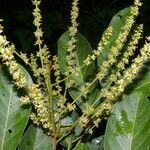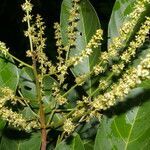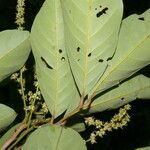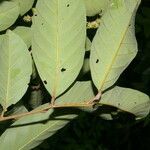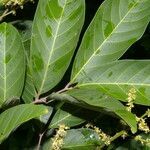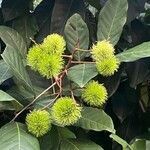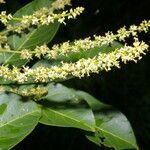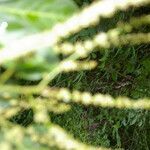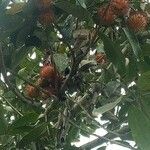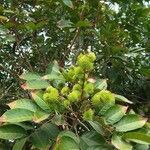Shrub or small tree; stems ferruginous-puberulous, glabrescent. Leaves paripinnate or imparipinnate or sometimes unifoliolate; petiole plus rachis to 16 cm long, terete or less often adaxially grooved; petiolules 3-5 mm long; leaflets 2-3 (-6) pairs, opposite or subopposite, coriaceous, adaxially glabrous, sometimes puberulent along midvein, dull, abaxially puberulent, oblong-elliptic, ovate or obovate, 5-28 × 2-10.5 cm, the apex obtuse, acute or obtusely acuminate, the base symmetrical, obtuse or acute, the margins entire. Inflorescences of axillary or distal, paniculate thyrses, as long as or longer than the subtending leaf. Calyx 0.7-2.1 mm long, the sepals free or connate at base; petals wanting or vestigial; disc annular, glabrous; stamens 5-8, ca. 3 mm long, filaments pubescent on lower half. Fruits often developing a single, ellipsoid-globose monocarp, ca. 3 (6) cm long, pericarp coriaceous, echinate, reddish, glabrous, the inner surface glabrous, cream. Seeds ellipsoid, 2.5-3 cm long, light brown, totally covered by a fleshy white-translucent sarcotesta.
A medium sized tree up to 12-25 m high. It keeps its leaves throughout the year. Trees spread to 6 m wide. The leaves are alternate with leaflets opposite along the stalk. There are 5-7 pairs of leaflets. Each leaflet can be 20 cm long by 8 cm wide. The leaflet stalks are short and the leaflets are pointed at the tip and rounded at the base. The flowers are very numerous on compound flower arrangements. Seedling trees can produce only female or only male trees. Some kinds have both male and female flowers or both flower parts in the one flower. The fruit are dark red with many prominent projections united at the base. The colour can vary between yellow, green, orange and bright red. Sometimes trees are separately male and female and sometimes seedless fruit is set. Often male and female flowers are separate but on the same tree. The fruit hang in loose clusters of 10-12 and are up to 5 cm long. Normally each fruit contains one large seed. There are several named cultivated varieties.
Trees, evergreen, ca. 10 m tall. Branches grayish brown, terete, rugose, ferruginous pilosulose when young. Leaves with petiole 15-45 cm, axis slightly strong, rugose when dry; leaflets (1 or)2 or 3(or 4) pairs; petiolules ca. 5 mm; blades elliptic or obovate, 6-18 × 4-7.5 cm, thinly leathery, glabrous, lateral veins 7-9 pairs, brownish red when dry, only prominent abaxially, net veins slightly honeycombed, visible on both surfaces when dry, base cuneate, margin entire, apex obtuse or slightly rounded, sometimes nearly acute. Inflorescences many branched, nearly as long as or longer than leaves, ferruginous tomentose. Pedicels short. Calyx ca. 2 mm, leathery; sepals ovate, tomentose. Petals absent. Stamens ca. 3 mm. Fruit reddish yellow, broadly ellipsoid, including spines ca. 5 × 4.5 cm, spines ca. 1 cm. Fl. early summer, fr. early autumn.
